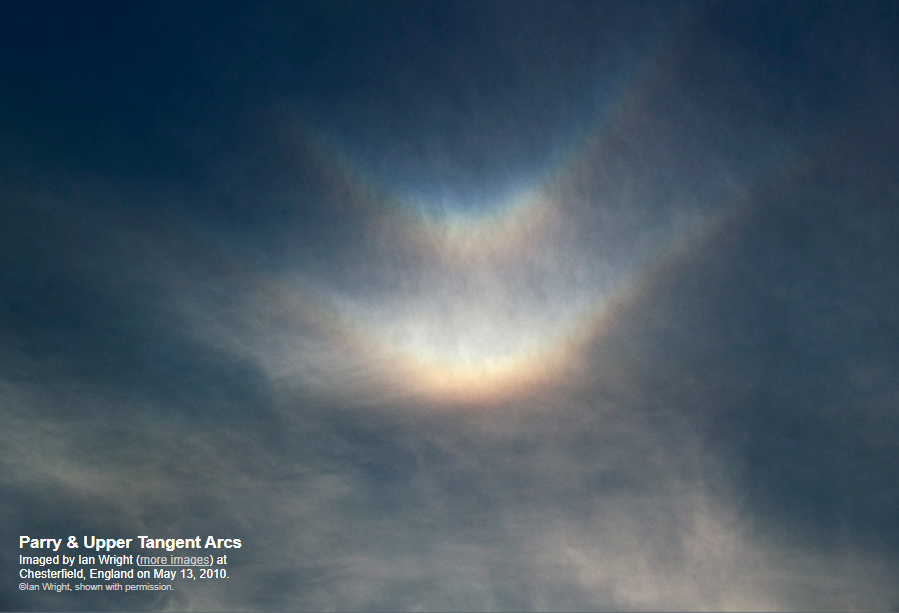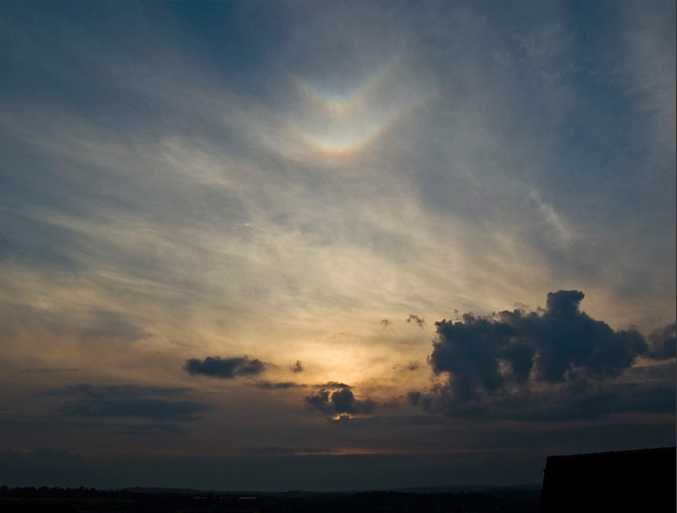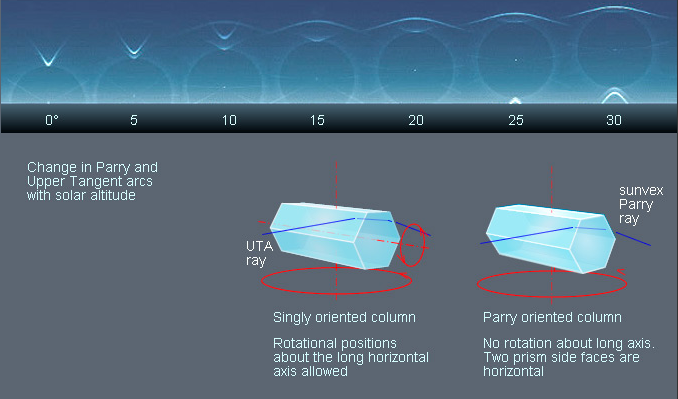Parry & Tangent Arcs
Parry & Tangent Arcs: Exploring Rare Atmospheric Optical Phenomena
Have you ever witnessed a mesmerizing display of colorful arcs in the sky during sunset or sunrise? These captivating optical phenomena are known as Parry and Tangent Arcs. While the Parry arc is a rare sight, the upper tangent arc is more commonly observed. In this article, we will delve into the fascinating world of these atmospheric optics phenomena and explore the science behind their formation.
Both Parry and Tangent Arcs are created by hexagonal column ice crystals present in high and cold cirrus clouds. These clouds, composed of tiny ice particles, provide the perfect conditions for the formation of these arcs. However, specific atmospheric conditions are required for these phenomena to occur, making them relatively uncommon sights.
To understand the formation of Parry and Tangent Arcs, it is essential to comprehend the alignment of ice crystals within the cloud. As these crystals drift slowly downwards relative to the air currents, aerodynamic drag plays a crucial role in their orientation. The drag aligns the crystal's long axis horizontally to within a degree or less.
Parry-oriented crystals have an additional orientation restriction, making them even more improbable. These crystals maintain a nearly horizontal side face. When a ray of light passes through two side faces inclined with a 60° prism wedge between them, it gives rise to two separate arcs - the Parry arc and the upper tangent arc.
One notable difference between these two arcs lies in their color purity. Parry arcs exhibit pure colors due to the vertical apex of the 60° prism wedge through which their rays pass. This vertical apex minimizes color overlap, resulting in distinct and vibrant hues. On the other hand, rays passing through the prism wedge of the upper tangent arc can rotate around the crystal's long axis. This rotation causes millions of differently oriented crystals to overlap, resulting in mixed colors.
Now, let's take a closer look at each of these arcs:
Parry Arcs:
- Parry arcs form a pure-colored upper 'V' shape in the sky.
- They are a rare sight and require a low sun angle, typically observed during sunrise or sunset.
- The apex of the prism wedge through which the rays pass is vertical, resulting in distinct colors without much overlap.
- Parry-oriented crystals have an improbable orientation, maintaining a nearly horizontal side face.
- The unique alignment of these crystals creates the distinct upper 'V' shape.
Upper Tangent Arcs:
- Upper tangent arcs are more commonly observed than Parry arcs.
- They appear as a less purely colored 'V' shape below the Parry arc, touching the 22° halo at its lowest point.
- Rays passing through the prism wedge can rotate around the crystal's long axis, causing color mixing.
- The rotation of millions of differently oriented crystals leads to the less pure colors observed in the upper tangent arc.
In addition to these arcs, a faint 22° halo may also be visible in the sky. This halo is caused by the refraction and reflection of light within the hexagonal ice crystals. The combination of Parry and Tangent Arcs along with the 22° halo creates a breathtaking atmospheric display.
To witness these stunning optical phenomena, one must be in the right place at the right time. A low sun angle, typically around sunrise or sunset, is necessary for the sunlight to interact with the ice crystals in a way that produces these arcs. Additionally, the presence of high and cold cirrus clouds is crucial for their formation.
In conclusion, Parry and Tangent Arcs are captivating atmospheric optical phenomena that occur due to the interaction of sunlight with hexagonal column ice crystals in high and cold cirrus clouds. While Parry arcs are rare and exhibit pure colors, upper tangent arcs are more commonly observed and display mixed hues. These arcs, along with the faint 22° halo, create a mesmerizing spectacle in the sky. So, keep an eye out during sunrise or sunset, and you might be lucky enough to witness these stunning displays of natural beauty.

Parry & Upper Tangent Arcs Imaged by Ian Wright (more images) at Chesterfield, England on May 13, 2010.
©Ian Wright, shown with permission.

A low sun is needed to capture this rare sight. Here sunset was approaching with the sun only ~7° high.
The pure coloured upper 'V' is a sunvex Parry arc. The noticeably less purely coloured lower 'V' is the much more common upper tangent arc that at its lowest extremity always touches the 22° halo. A very faint 22° halo is visible at right.
Both are produced by hexagonal column ice crystals in high and cold cirrus cloud.
Aerodynamic drag aligns the columns as they drift very slowly downwards relative to air currents within the cloud. The drag aligns the crystal long axis so that it is horizontal to within a degree or less.
Parry oriented crystals have a further - and improbable - orientation restriction. A side face is maintained nearly horizontal.
The orientation differences give rise to the two separate arcs from a ray that passes through two side faces inclined with a 60° prism wedge between them.
Colour purity?
Parry arcs have pure colours because the 60° prism wedge through which their rays pass has its apex vertical. The dispersed colours therefore have little overlap.
In contrast, the upper tangent arc rays pass through a prism wedge that can rotate around the crystal long axis. Rays from the millions of differently oriented crystals overlap and the colours are mixed.

Note: this article has been automatically converted from the old site and may not appear as intended. You can find the original article here.
Reference Atmospheric Optics
If you use any of the definitions, information, or data presented on Atmospheric Optics, please copy the link or reference below to properly credit us as the reference source. Thank you!
-
<a href="https://atoptics.co.uk/blog/parry-tangent-arcs/">Parry & Tangent Arcs</a>
-
"Parry & Tangent Arcs". Atmospheric Optics. Accessed on December 22, 2024. https://atoptics.co.uk/blog/parry-tangent-arcs/.
-
"Parry & Tangent Arcs". Atmospheric Optics, https://atoptics.co.uk/blog/parry-tangent-arcs/. Accessed 22 December, 2024
-
Parry & Tangent Arcs. Atmospheric Optics. Retrieved from https://atoptics.co.uk/blog/parry-tangent-arcs/.